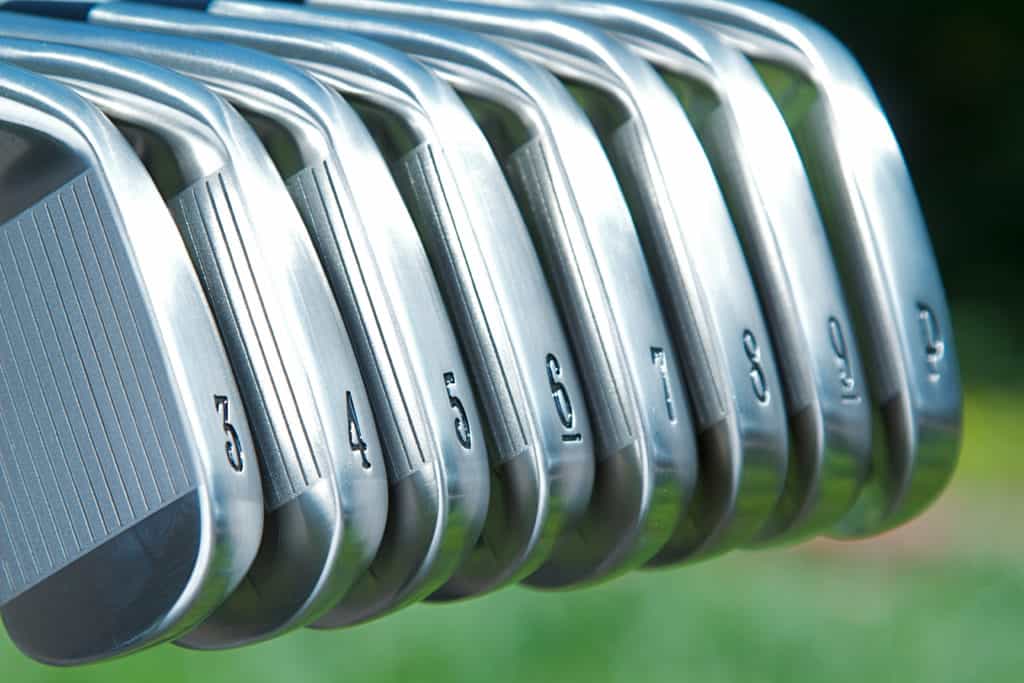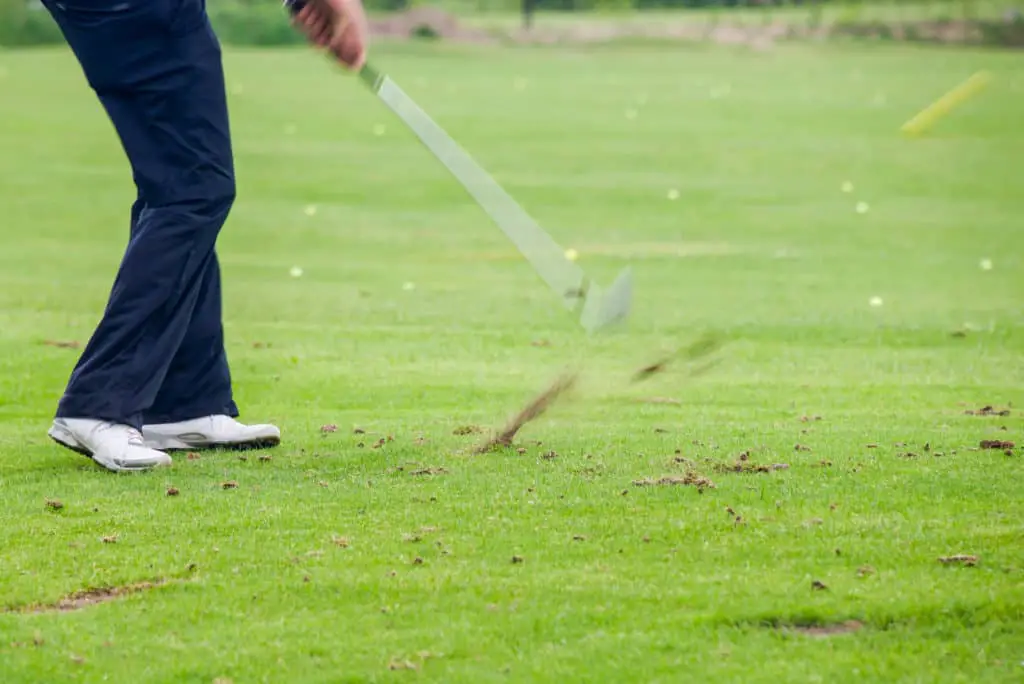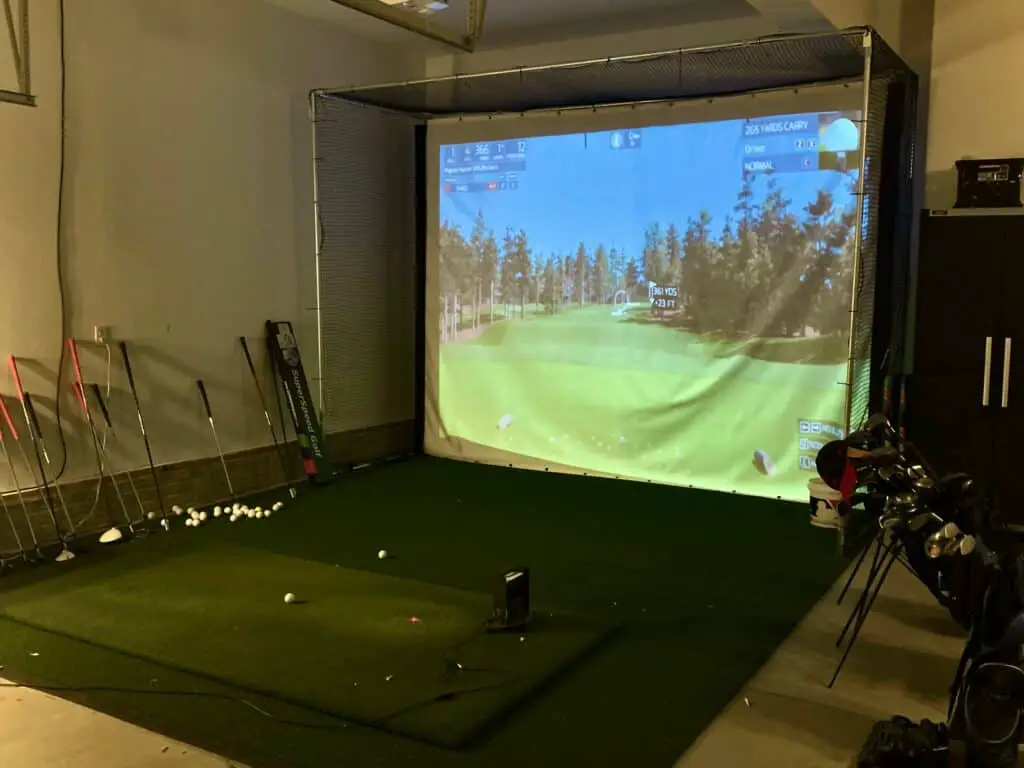Every golfer wants to maximize the 14 clubs they are able to carry in their bag.
In today’s golf world there are plenty of options. With the hybrids hitting the market and offering many different lofts, some golfers might consider replacing a 6 iron with a hybrid or a fairway wood.
While there might not seem to be a big difference between a 6 iron and a 7 iron, there are some noticeable differences in both the loft and what type of shot you might play with each club.
6 Iron vs 7 Iron
Most 6 irons in today’s game have around 28 degrees of loft, while a 7 iron has 31 degrees of loft. The 6 iron is about .5 inches longer in shaft length. The noticeable difference when swinging the 6 iron is that it will fly further and a bit lower, while the 7 iron will fly higher but a bit shorter.
How to hit a 7 iron (5 Keys and Tips)
How to hit a 6 iron (5 Keys and Tips)
Here is an overview of the length and loft of the most commonly carried clubs:
| Club Number | Driver | 3 Wood | 3 | 4 | 5 | 6 | 7 | 8 | 9 | P |
| Degree | 9 | 15 | 19 | 22 | 25 | 28 | 31 | 35 | 39 | 43 |
| Length | 46 | 43.5 | 39.00″ | 38.50″ | 38.00″ | 37.50″ | 37.00″ | 36.50″ | 36.00″ | 35.75″ |
Note: Throughout the post there are different links that will help you dive deeper into specific questions you might have about the 6 iron or 7 iron.

6 Iron vs 7 Iron: Differences
The 6 iron for some golfers will start to feel like a long iron and become difficult to hit. For many years, the 6 iron had around 31 degrees in the loft, but over the past decade or so golf manufacturers have started to reduce the amount of loft on clubs.
For many golfers, the long irons are the most difficult clubs to hit, but there are plenty of options in today’s game for the golfer that struggles with the long irons.
The main difference is the little less loft that a 6 iron has can make it difficult for a golfer that lacks enough swing speed to elevate and truly hit the 6 iron how it is intended to be hit.
The 7 iron is a club that over 90% of golfers will carry and has enough loft to help the golfer hit successful shots.
Longer irons can be difficult to hit for those that lack swing speed and the 6 iron is where irons can become difficult to hit for some golfers.
6 Iron vs 6 Hybrid: When to make the change
6 Iron vs 7 Iron: Similarities
Since there is only 3 degrees of difference in loft and only a .5 inch difference in length of the club, the 6 and 7 iron will seem similar for many golfers. For the golfer with enough swing speed that hits the ball solid, you will find about a 10-12 yard difference in carry distance.
Both clubs are played in similar spots as far as ball positions and feel somewhat similar when struck properly. Obviously, the 6 iron is going to fly 10-12 yards further and be used on the longer shots.

6 Iron vs 7 Iron: Key Tip #1 – Control Your Low Point
Whether you are hitting a 6 iron or 7 iron, a key to hitting both successfully is to control your low point, which will help you hit the ball solidly. If you can only hit your 6 iron as far as your 7 iron, it probably is due to the lack of solid contact. Below is a drill to help you out!
The Low Point Control Drill
- Take some yard paint and paint a 1-2 yard long line.
- Setup with 55% of your weight on your front side.
- Try to hit the target side of the line and see how many times out of 10 you can do this successfully!
- Repeat this drill every day for a month, tracking your progress and your ability to to this successfully in trials of ten.
- You may need to start with half swing and progress to full swings.
If you are struggling, put more weight forward and work on keeping your head still to help control the low point in the swing.
How to hit a 7 iron 200 yards!
6 Iron vs 7 Iron: Key Tip #2 – Develop A Stock Shot
All good players have a go to shot with every club in their bag. Since the 6 and 7 iron are pretty in design and performance, I would recommend the same shot, whether a draw or fade be your go to shot with both clubs. I am a big fan of developing a stock shot in golf, which helps you eliminate the really bad misses and dial in your accuracy and distance control.
If you stand over a shot and have no idea where it is going to end up, check out this drill below to help you develop a stock shot and take your game to the next level!
The Drill: Stock Shot Drill
- At the driving range, set up an alignment stick about 6-8 yards in front of you, straight down your target line.
- If you have a second alignment stick, set the stick 3-4 feet right of the first stick (for a draw) or left of the first stick (for a fade).
- Complete your initial assessment see how many times out of 10 you can start the ball to the right or left of your target. Pick one side and measure your game at this point.
- The goal is to eventually get 7 out of 10 shots to start to the correct side and draw back towards the target.
6 Iron vs 7 Iron: Key Tip #3 – Understand Your Distances
Understand the differences in the length that you hit each club. Too many golfers might say, “Oh, I hit my 7 iron 160 yards” but are really overestimating when in reality they actually hit a 6 iron 160 yards.
They head to a par 3 with a front pin that is tucked behind a bunker and need to carry the shot 155 to cover the bunker. They pull their 7 iron out of the bag and come up a bit short and end up making bogey or even worse and ruining their round.
The key here would have been to understand the precise distance you hit a 6 iron and a 7 iron under normal conditions.

How can a golfer create a true understanding of how far they hit each club?
I would highly recommend each golfer create a distance chart like the sample below:
| Club | Carry Distance (100%) | 90% | 80% |
| 2 Utility Iron | 210 | ||
| 4 iron | 190 | ||
| 5 iron | 181 | ||
| 6 iron | 171 | ||
| 7 iron | 163 | ||
| 8 iron | 153 | ||
| 9 iron | 143 | ||
| P Club | 130 | 123 | 115 |
| Pitching Wedge | 118 | 110 | 102 |
| SW Club | 105 | 97 | 91 |
| LW Club | 90 | 82 | 74 |
This might be the most important information you can use to help you play quality golf. I have heard so many stories and have seen it first hand where golfers completely over estimate how far they hit each iron.
They hit one 7 iron 165 yards one time and think this is their carry distance. So they step up to a 165 yard shot, hit the 7 iron and end up in a bunker. They blade it out of the bunker and are looking at a double bogey as their reality. Instead, if they had the right club and hit the 6 iron, their chance of hitting the middle of the green would increase greatly!
Rangefinder vs GPS: Which one should you buy?
How can you create your own chart?
Best Option: I would highly recommend a launch monitor!
These portable devices can be used at the driving range, golf course or set up in your home net or golf simulator. These devices are game changers not only on being able to map your bag and know your distances, but they also provide quality feedback after on every shot and provide the following information:
- Carry Distance
- Spin Rate
- Launch Angle
- Spin Axis
- Total Distance
- Ball Speed
This information will help you map your bag, decide on which clubs are best for your game, develop a stock shot and much more. I love using my SkyTrak 365 days a year in my golf simulator setup.
The process for mapping your bag can looking something like this:
- Hit 5 shots with each club in your bag.
- Log the carry distance and total distance for each shot.
- Eliminate any outlier numbers (poor hits or low spin rates).
- Take the average and create a map of your bag.
If you visit any PGA Tour event you will see plenty of golfers utilizing their launch monitors. While most can’t afford a Trackman, there are some very affordable options in the 500-2000 dollar range. I own the SkyTrak and think the world of it.
Here are the top 3 options to check out:
My Secret To Golf Improvement
Let’s face it, in order to get really good at golf, we must practice frequently. About four years ago, I made the leap and invested in a golf simulator build for my garage. I went with a SkyTrak Launch Monitor and the TGC software and can now play over 100,000 courses including Augusta, Pebble Beach, Bethpage Black, Whistling Straits. St. Andrews and many other of the top 100 courses in the world.
This golf simulator setup, which is more affordable that you might imagine, has been a game changer. I can now play golf everyday of the year regardless of rain, snow, cold weather or time of day. I can practice or play rounds of golf. I can stand in the 11th fairway at Augusta and with the auto-rewind feature I am able to practice my approach shots from various differences.
It is worth checking out through Rain or Shine Golf as they offer some incredible packages along with financing offers that are difficult to beat.
Some direct links to Rain or Shine Golf for pricing and financing:

Take Action – What You Can Do Today to Get Better
What does this mean for you? I believe in the following recipe to get better:
1 – Improve your motion in the golf swing by identifying a golf instructor. Here are some options:
Here is a list of golf instructors that we have reviewed:
2 – Train to swing faster and improve your swing speed. Here are some options:
Looking to gain more Speed and Distance in your swing. Two Options:
3 – Understand course strategy and work to break through your next barrier. Here is a series on breaking through:
We have provided guides on how to break 100, 90, 80 and 70. Check out more below, if interested.
4 – Practice Frequently
Did you know that I build a golf simulator in my garage and have played over 500 rounds of golf on my SkyTrak system? It has been a game changer and one worth checking out. Here are some of my other posts on golf simulators frequently asked questions:
- Is a Golf Simulator Worth It?
- How to Build a Golf Simulator?
- What is the Best Golf Simulator?
- Golf Simulator Accessories?
- How to Build a Golf Simulator for under $7000
- Top 11 Reasons to Buy a SkyTrak
- How to Build a Golf Simulator for Under $1000
- Why Build A Golf Simulator?
- What Space is Needed?
- Can A Golf Simulator Improve My Game?
- How Much Does A Golf Simulator Cost?
- Don’t Forget to Check out our 15 best golf swings of all time.

